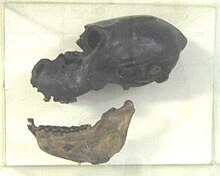

| Paralouatta Temporal range: Early Miocene-Quaternary | |
|---|---|

| |
| Paralouatta marianae skull | |
| Scientific classification | |
| Domain: | Eukaryota |
| Kingdom: | Animalia |
| Phylum: | Chordata |
| Class: | Mammalia |
| Order: | Primates |
| Suborder: | Haplorhini |
| Infraorder: | Simiiformes |
| Family: | Atelidae |
| Subfamily: | Alouattinae |
| Genus: | †Paralouatta Rivero & Arredondo 1991 |
| Type species | |
| †Paralouatta varonai Rivero & Arredondo 1991 | |
| Species | |
| |
Paralouatta is a platyrrhine genus that currently contains two extinct species of small primates that lived on the island of Cuba.
Paralouatta varonai was described from a nearly complete cranium from the late Quaternary in 1991. This cranium and a number of isolated teeth and postcranial bones were found in the Cueva del Mono, a cave site in Pinar del Río Province. The initial description of the cranium included a proposal that Paralouatta varonai was a close Caribbean relative of the extant Alouatta (howler monkeys) of Central and South America,[1] but this taxonomic placement was called into question with the analysis of the dental remains.[2] Based on shared similarities with the three other Caribbean monkeys, Xenothrix mcgregori, Insulacebus toussaintiana, and Antillothrix bernensis, MacPhee and Horovitz have proposed that the Caribbean primates are part of a monophyletic radiation which entered the Caribbean at the Oligocene–Miocene boundary. Further research confirms this assessment and places these three species in the tribe Xenotrichini.[3] However, more recent research restores its close relationship with Alouatta.[4] The postcranial morphology of Paralouatta suggests that it was partly terrestrial,[5] and a likely example of island gigantism.[6]
A second species of Paralouatta (P. marianae) has also been described from the Burdigalian (~18 million years old) Lagunitas Formation and is the largest Neotropic primate known of that epoch.[6]
Paralouatta had an estimated body mass of 8.4 kg (19 lb).[4] Analysis of postcranial morphology suggests that Paralouatta was at least somewhat semi-terrestrial, making it the most terrestrial platyrrhine genus known.[7]
| Paralouatta |
|
|---|---|
| Paralouatta varonai |
|